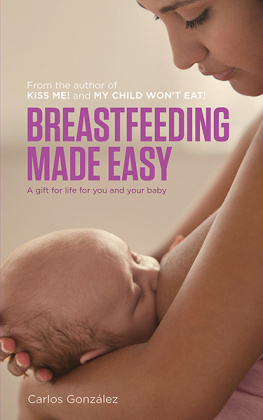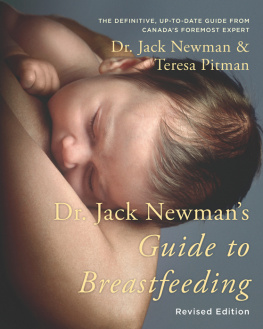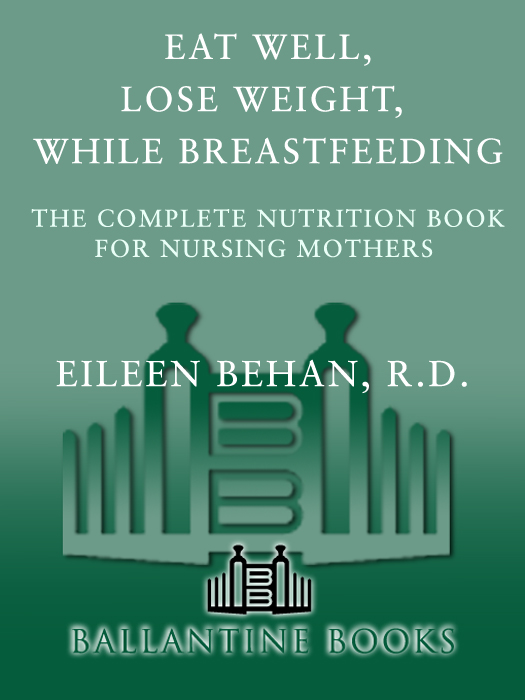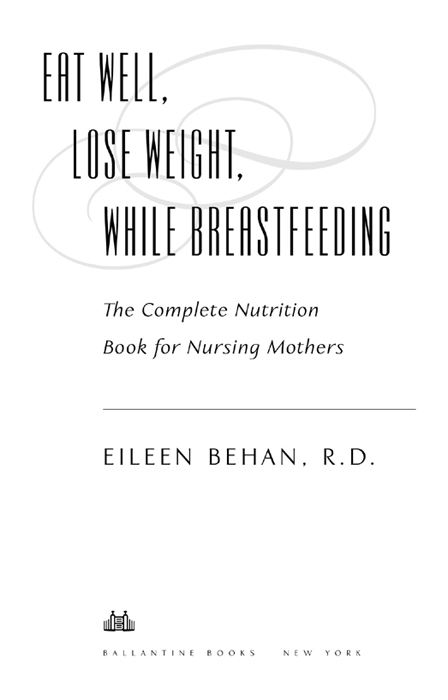ALSO BY EILEEN BEHAN, R.D.
Microwave Cooking for Your Baby and Child
The Pregnancy Diet
Fit Kids: Raising Physically and Emotionally Strong Kids with Real Food
Meals That Heal for Babies, Toddlers, and Children
Therapeutic Nutrition: A Guide to Patient Education
Cooking Well for the Unwell
Eat Well, Lose Weight, While Breastfeeding is not a substitute for medical advice. If you suffer from any illness that requires you to be on medication, please consult a qualified physician (one who is sensitive to lactation issues) for advice on nursing your baby. Please also be aware that the websites and other resources to which reference is made in this book are subject to change. The authors and publisher are not responsible for the accuracy or reliability of information, products, or services offered by any third-party or available on third-party websites.
A Ballantine Books Trade Paperback
Copyright 1992, 2006 by Eileen Behan, R.D.
All rights reserved.
Published in the United States by Ballantine Books,
an imprint of The Random House Publishing Group,
a division of Random House, Inc., New York.
B ALLANTINE and colophon are registered trademarks
of Random House, Inc.
Originally published in a different form and in paperback
in the United States by Villard Books, an imprint of
The Random House Publishing Group, a division of
Random House, Inc., in 1992.
eISBN: 978-0-345-54057-7
Library of Congress Cataloging-in-Publication Data
Behan, Eileen.
Eat well, lose weight, while breastfeeding : the complete nutrition book for nursing
mothers / Eileen Behan R.D.[Rev. ed.]
p. cm.
A Ballantine Books trade paperback
Includes bibliographical references and Index.
ISBN 978-0-345-49259-3
1. Breastfeeding. 2. MothersNutrition. 3. LactationNutritional aspects.
4. Reducing diets. I. Title.
RJ216.B34 2006
613.269dc22 2006048358
www.ballantinebooks.com
v3.1
In memory of my father, John M. Behan,
and my mother, Elizabeth J. Behan
To David, Sarah, and Emily.
We did it again. Thank you.
ACKNOWLEDGMENTS
T o my mother, Sharon, Sheila, and Kevin, thanks for your continuous encouragement. Trish Cronan, Brad Lavigne, as always you are a steadfast source of support. Judith Paige, Marilyn DeSimone, Madeleine Walsh, as friends and competent nutritionists, you continue to help me refine my idea. Id like to thank Ms. Ana Ortiz for efficient and accurate nutritional analysis of menus, and Susan Yorstin, thanks again for proofreading. Ms. Susan Cotter, Jennifer Quirk, and Kathleen Beede, thank you for your comments and development of the exercise program.
I would like to thank the following nutrition and lactation experts who generously gave their time to read all or part of this before it went to print: Nancy F. Butte, Ph.D., Childrens Nutrition Research Center, Houston, Texas; Bette Crase of the Center for Breastfeeding Information at La Leche League International; Kathyryn Dewey, Ph.D., professor, Department of Nutrition, University of California, Davis, California; Lois Jovanovic-Peterson, M.D., senior scientist, Sansum Medical Research Foundation, Santa Barbara, California; Ruth A. Lawrence, M.D., professor of pediatrics, obstetrics, and gynecology, University of Rochester Medical Center, Rochester, New York; Susan Luke, M.S., R.D., nutritionistsports medicine, Boston, Massachusetts; Arnold Schecter, M.D., professor of preventive medicine, State University of New York, Binghamton, New York.
At Villard Books I would like to thank Emily Bestler and her assistant, Tom Fiffer, for working patiently with me. I am also thankful to the others at Villard who contributed significantly to this book: Richard Aquan, Nancy Inglis, and Amy Ryan. Thank you to Johanna Bowman and Rebecca Shapiro at Ballantine for their skillful revisions. I would also like to thank Patricia Martin for typing the revised manuscript.
To Allison Acker and Carol Mann, once again you both saw possibilities in my idea.
CONTENTS
INTRODUCTION
Spring 2007
A lot has changed in the world since the first edition of Eat Well, Lose Weight, While Breastfeeding was published in 1992. The main principlethat breastfeeding is the undisputed best way to feed babieshas, however, remained a constant. Research continues to confirm the tremendous health benefits of breastfeeding for both mother and child.
Though eating well remains a fundamental principle to a satisfying nursing experience, there are no absolute food rules. Women from around the world eat a variety of foods and breastfeed successfully. When it comes to weight loss, the slow and steady approach is advised. Eat Well, Lose Weight, While Breastfeeding survived the no-fat diets of the 1990s and the no-carb craze popular in the early years of the twenty-first century. Neither extreme led to permanent weight loss. In fact, the opposite occurred. After thirty years as a nutrition educator, I have learned that those who are successful with permanent weight control are the women who adopt a healthy lifestyle.
This edition updates the content of the earlier book and includes information on new trends and concerns. The fundamental message, however, remains the same: eat well and you will lose weight and be healthy. Give your body the food it needs, allow time to care for and nurse your baby, and both of you will have a satisfying breastfeeding experience.
There is a new issue added to this revised edition. The rise in . In 1992, 25 percent of adult women were considered overweight. Now it is 50 percent of women. In this section you will read what to do after you stop nursing and your baby is on solid foods. Many family health specialists now describe our food environment as toxic because it promotes processed foods, highly advertised snacks, and harried meals that make it almost impossible to eat well and control weight. Planning family meals that are structured and predictable and contain wholesome food is the antidote to our less than perfect food environment. This edition provides me with an opportunity to offer some guidance in the area of introducing foods and establishing routines that I believe will lay the foundation for your familys meal and eating routines for years to come.
Eileen Behan
INTRODUCTION
First Edition
Y ou should know better! Those were my doctors words as I sat in her office, nine months pregnant and weighing 187 pounds. She hadnt expected me to gain 52 pounds during my pregnancy. I am a registered dietitian, and food, nutrition, and diets are my business. But like many first-time moms I regarded pregnancy as a time to relax my eating standards. Almost every night I ate a bowl of delicious rich ice cream. I also snacked much more and found that if I didnt eat often I didnt have quite enough energy. In the beginning, food also helped fight nausea.
I really wasnt worried about my weight. I had always been able to maintain my weight between 130 and 135 pounds, which is fine for my five-foot, eight-inch frame. I figured after the baby was born, I would just get back to exercising and eating right and those excess pounds would melt away.
Three hours after my daughter Sarah was delivered by cesarean section, a food tray was brought to me. It carried coffee, red Jell-O, and chicken broth. These bland foods were supposed to restore my energy without taxing my digestive tract.







